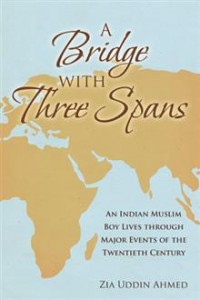Title: A Bridge with Three Spans: An Indian Muslin Boy Lives through Major Events of the Twentieth Century
Author: Zia Uddin Ahmed
Publisher: iUniverse
ISBN: 9781491791936
Pages: 248k
Genre: Biography & Autobiography/Cultural Heritage
Reviewed by: Carol Davala
Buy on AmazonPacific Book Review
As a young boy in India, Zia Uddin Ahmed’s mischievous act of stealing sweet pink- fleshed fruit from his uncle’s guava tree, led to consequences that ultimately became a valuable life lesson and turned him into an avid reader with a keen interest in world affairs. Similar stories of his youth, academic years, working career, and beyond are intricately woven into the detailed framework of Ahmed’s autobiographical work “A Bridge with Three Spans.” Here the author offers up his life’s journey in a trio of phases, from the early years in India with his parents, relatives, and extended family, to college life and subsequent work as a civil servant in Pakistan, then on to a third span highlighting travel abroad, and a career with the International Center for Public Enterprises (ICPE) and the UN. Each segment is characteristically infused with the author’s personal account of events of the time, and rendered with a keen eye for the geographic, historic, and cultural surroundings.
From his roots in the district of Gaya where the great Buddha achieved enlightenment, Ahmed quickly draws his readers beyond the “purdah” (curtains) used to divide men and women at functions. Recollections include annual visits to his Nani (grandmother), the elders’ paan indulgence (a habit forming tobacco and spice concoction), and back massages given to relatives using the soles of his feet. Ahmed saw beauty in the flowering mahwa trees, and realized the power of nature in an overflowing Ganges. Within his own family circle he experienced the casualties of limited health care, and even in the present, remains saddened by the memory of an earlier days’ funeral processions marking a cholera epidemic. Bringing nuance and an added dimension to this narrative, Ahmed creatively enhances his writing with well-known source material. When limited on the specifics of his widowed aunt’s spiritual adventure to Mecca, the author taps into Joseph Conrad’s “Lord Jim” novel, to shed light on the event.
In the second arc of this book, complimented by personal photographs, in mind of a finely detailed travelogue, Ahmed artfully renders his venture into the world. Beginning with an eleven-day train/boat journey that covered 2,680 miles, he goes on to handle a difficult college science curriculum, pursue a love of books and literature, continue his educational goals, marry, and land a job with Pakistan’s Audit & Accounts Service. Though events are not always chronological, amidst this informative landscape and architectural tour we envision the likes of Badshahi Mosque, the beautiful Shalimar Gardens, the displacing Rangamati Lake, and the sacred Buddhist Pagoda of Yangon.
Career advancement in the mid-60s led to Ahmed’s work with Pakistan’s team of auditors for the UN and its affiliate agencies. Excitement is obvious as he recounts visiting the NY headquarters, a world of skyscrapers and engineering marvels. The spotlight follows with his later work for the ICPE. In travels from Yugoslavia to a posting in Malawi, Ahmed points to the dramatic contrast of a European country that embraces workers’ self-management. Even in retirement we see that Ahmed’s thirst for knowledge and travel prevails. From Myanmar he shares the importance of elephants in the logging industry, while in Ethiopia he recognizes the home of mankind’s origins with the famous “Lucy” fossil findings. This is a land of giant obelisks marking ancient burial chambers, where papyrus boats move slowly across Lake Tana, and pilgrimage areas represent a “new Jerusalem.”
While Ahmed’s writing certainly fulfills his intent to capture personal memories, his story is also a creative rendering of acute observations that reveal spans of time, place, and relevant history. The final result is a fluid memoir that depicts a life truly enriched by its connective experiences.



Follow Us